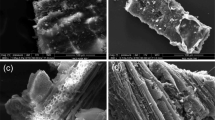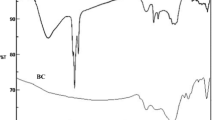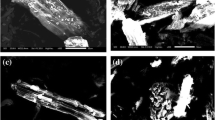Abstract
As can be volatilized naturally; however, this has adverse environmental effects. In this study, we investigated As volatilization in flooded paddy soil with the addition of biochar (BC) and Fe–Mn–La-modified BC composites (FMLBCs). The addition of BC and FMLBCs caused decreases in total As volatilization in the soil over 7 weeks. Maximum volatilization was achieved in the third week followed by stabilization. Volatilization decreased by 21.9%, 18.8%, 20.8%, and 31.1% with the addition of BC, FMLBC1, FMLBC2, and FMLBC3 (BC/Fe/Mn/La weight ratios different), respectively, in lightly contaminated soil, and by 15.2%, 20.5%, 17.6%, and 25.4%, respectively, in highly contaminated soil. The FMLBCs decreased the exchangeable As fractions and increased the non-swappable As in the soil. Furthermore, the addition of FMLBCs significantly reduced the As(III) concentration in a suspended solution (P < 0.05), whereas no significant changes were observed in the As(V) or methyl arsenic acid concentrations. Soil enzyme activity increased and the relative abundances of Proteobacteria and Actinobacteria changed with the addition of FMLBCs. Therefore, the mechanism by which FMLBCs affected As volatilization likely included the following two aspects: (1) FMLBCs affected the transformation and distribution of soil As and decreased As dissolution, crystallization, and methylation; (2) FMLBCs influenced soil properties, which directly affected microorganism activity, thereby affecting As volatilization. FMLBCs therefore can decrease As volatilization properties and be used to control As volatilization in As-contaminated paddy soils.






Similar content being viewed by others
References
Arao T, Kawasaki A, Baba K, Matsumoto S (2011) Effects of arsenic compound amendment on arsenic speciation in rice grain. Environ Sci Technol 45(4):1291–1297
Beesley L, Marmiroli M, Pagano L, Pigoni V, Fellet G, Fresno T, Vamerali T, Bandiera M, Marmiroli N (2013) Biochar addition to an arsenic contaminated soil increases arsenic concentrations in the pore water but reduces uptake to tomato plants (Solanum lycopersicum L.). Sci Total Environ 454:598–603
Campos NV, Arcanjo-Silva S, Viana IB, Batista BL, Barbosa F, Loureiro ME, Ribeiro C, Azevedo AA (2015) Arsenic-induced responses in Pityrogramma calomelanos (L.) Link: arsenic speciation, mineral nutrition and antioxidant defenses. Plant Physiol Biochem 97:28–35
Cao Q, Steinman AD, Su X, Xie L (2017) Effects of microcystins contamination on soil enzyme activities and microbial community in two typical lakeside soils. Environ.Pollut 231:134–142
Chen J, Sun G, Wang X, Vd L, Rosen BP, Zhu Y (2014) Volatilization of arsenic from contaminated soil by Pseudomonas putida engineered for expression of the arsM Arsenic(III) S-adenosine methyltransferase gene. Environ Sci Technol 48:10337–10344
Chen Z, Wang YP, Xia D, Jiang XL, Fu D, Shen L, Wang H, Li B (2016) Enhanced bioreduction of iron and arsenic in sediment by biochar amendment influencing microbial community composition and dissolved organic matter content and composition. J Hazard Mater 311:20–29
Chen Y, Xu J, Lv Z, Xie R, Huang L, Jiang J (2018) Impacts of biochar and oyster shells waste on the immobilization of arsenic in highly contaminated soils. J Environ Manag 217:646–653
Cho DW, Jeong KH, Kim S, Tsang DCW, Ok YS, Song H (2018) Synthesis of cobalt-impregnated carbon composite derived from a renewable resource: characterization and catalytic performance evaluation. Sci Total Environ 612:103–110
Christoph S, Murilorodrigues DA, Wenceslaug T, Wolfgang Z (2010) Soil respiration curves as soil fertility indicators in perennial central Amazonian plantations treated with charcoal, and mineral or organic fertilisers. Trop.Sci. 47(4):218–230
Ehlert K, Mikutta C, Kretzschmar R (2014) Impact of birnessite on arsenic and iron speciation during microbial reduction of arsenic-bearing ferrihydrite. Environ Sci Technol 48:11320–11329
Feng X, Zu Y, Tan W, Liu F (2006) Arsenite oxidation by three types of manganese oxides. J Environ Sci 18:292–298
Hong C, Si Y, Xing Y, Li Y (2015) Illumina miseq sequencing investigation on the contrasting soil bacterial community structures in different iron mining areas. Environ Sci Pollut Res 22(14):10788–10799
Huang, H., Jia, Y., Sun, G., Zhu,Y., 2012. Arsenic speciation and volatilization from flooded paddy soils amended with different organic matters, Environ Sci Technol 46, 2163–2168.
Huang Q, Zhou S, Lin L, Huang Y, Li F, Song Z (2018) Effect of nanomaterials on arsenic volatilization and extraction from flooded soils. Environ Pollut 239:118–128
Jia Y, Huang H, Sun GX, Zhao FJ, Zhu YG (2012) Pathways and relative contributions to arsenic volatilization from rice plants and paddy soil. Environ Sci Technol 46:8090–8096
Jia Y, Huang H, Zhong M, Wang FH, Zhang LM, Zhu YG (2013) Microbial arsenic methylation in soil and rice rhizosphere. Environ Sci Technol 47:3141–3148
Jia Y, Huang H, Chen Z, Zhu Y (2014) Arsenic uptake by rice is influenced by microbe-mediated arsenic redox changes in the rhizosphere. Environ Sci Technol 48(2):1001–1007
Lehmann J, Gaunt J, Rondon M (2006) Bio-char sequestration in terrestrial ecosystems e a review. Mitig Adapt Strateg Glob Chang 11:403–427
Li J, Yuan S, Wang W, Ji F, Hu Z (2015) Adsorption characteristics of 4-hydroxy-3-aminophenylarsonic acid (HAPA) onto anaerobic granular sludge. Desalin Water Treat:1–12
Lin L, Song Z, Liu X, Khan ZH, Qiu W (2019a) Arsenic volatilization in flooded paddy soil by the addition of Fe-Mn-modified biochar composites. Sci Total Environ 674:327–335
Lin L, Song Z, Khan ZH, Liu X, Qiu W (2019b) Enhanced As(III) removal from aqueous solution by Fe-Mn-La-impregnated biochar composites. Sci Total Environ 686:1185–1193
Lin L, Gao M, Liu X, Song Z (2020) Influence of the application of Fe–Mn–La ternary oxide-biochar composites on the properties of arsenic-polluted paddy soil. Environ Sci Process Impacts 2020(22):1045–1056
Liu Z, Xu J, Li X, Wang J (2018) Mechanisms of biochar effects on thermal properties of red soil in south china. Geoderma 323:41–51
Liu C, Tian H, Li H, Wang Z, Megharaj M, He W (2019) The accuracy in the assessment of arsenic toxicity using soil alkaline phosphatase depends on soil water contents. Ecol Indic 102:457–465
Lyubun YV, Pleshakova EV, Mkandawire M, Turkovskaya OV (2013) Diverse effects of arsenic on selected enzyme activities in soil-plant-microbe interactions. J. Hazard Mater 262:685–690
Makoi J, Ndakidemi PA (2008) Selected soil enzymes: examples of their potential roles in the ecosystem. Afr J Biotechnol 7:181–191
Marcussen H, Ha T, Polprasert C, Holm PE (2012) Contents and mass balances of cadmium and arsenic in a wastewater-fed fishpond of Hoang Mai, Hanoi, Vietnam. J Environ Sci Heal A 47:2246–2253
Meier S, Azcón R, Cartes P, Borie F, Cornejo P (2011) Alleviation of Cu toxicity in Oenotherapicens is by copper-adapted arbuscular mycorrhizal fungi and treated agro-waste residue. Appl Soil Ecol 48:117–124
Mestrot A, Merle JK, Broglia A, Felogydmann J, Krupp EM (2011) Atmospheric stability of arsine and methylarsines. Environ Sci Technol 45:4010–4015
Mestrot A, Xie W, Xue X, Zhu Y (2013) Arsenic volatilization in model anaerobic biogas digesters. Appl Geochem 33:294–297
Michalke K, Wickenheiser EB, Mehring M, Hirner AV, Hensel R (2000) Production of volatile derivatives of metal(loid)s by microflora involved in anaerobic digestion of sewage sludge. Appl Environ Microbiol 66:2791–2796
Mumford, A. C., Barringer, J. L., Benzel, W. M., Reilly, P. A., Young, L., 2012. Microbial transformations of arsenic: mobilization from glauconitic sediments to water. Water Res 46(9), 0–2868, 2859.
Popovic A, Djordjevic D, Polic P (2001) Trace and major element pollution originating from coal ash suspension and transport processes. Environ Int 26(4):251–255
Rinklebe J, Shaheen SM, Yu KW (2016) Release of As, Ba, Cd, Cu, Pb, and Sr under pre-definite redox conditions in different rice paddy soils originating from the USA and Asia. Geoderma 270:21–32
Shaheen SM, Rinklebe J, Frohne T, White JR, DeLaune RD (2016) Redox effects on release kinetics of arsenic, cadmium, cobalt, and vanadium in Wax LakeDeltaic freshwater marsh soils. Chemosphere 150:740–748
Shariatpanahi M, Anderson AC, Abdelghani AA, Englande AJ, Hughes J, Wilkinson RF (1981) Biotransformation of the pesticide sodium arsenate. J Environ Sci Health Part B: Pesticides, Food Contam Agric Wastes 16:35–47
Shimizu M, Arai Y, Sparks DL (2011) Multiscale assessment of methylarsenic reactivity in soil. 2. Distribution and speciation in soil. Environ Sci Technol 45:4300–4306
Su S, Zeng X, Feng Q, Bai L, Zhang L, Jiang S, Li A, Duan R, Wang X, Wu C, Wang Y (2015) Demethylation of arsenic limits its volatilization in fungi. EnvironPollu 204:141–144
Suda A, Makino T (2016) Functional effects of manganese and iron oxides on the dynamics of trace elements in soils with a special focus on arsenic and cadmium: a review. Geoderma 270:68–75
Tang R, Chen H, Yuan S, Zhan X, Wang W, Hu Z (2017) Arsenic accumulation and volatilization in a 260-day cultured upflow anaerobic sludge blanket (UASB) reactor. Chem Eng J 311:277–283
Wang P, Sun G, Jia Y, Meharg AA, Zhu Y (2014) A review on completing arsenic biogeochemical cycle: microbial volatilization of arsines in environment. J Environ Sci 26:371–381
Wang N, Xue X, Juhasz AL, Chang Z, Li H (2017) Biochar increases arsenic release from an anaerobic paddy soil due to enhanced microbial reduction of iron and arsenic. Environ Pollut 220:514–522
Wang Y, Ji H, Lu H, Liu Y, Yang R, He L, Yang S (2018) Simultaneous removal of Sb(III) and Cd(II) in water by adsorption onto a MnFe2O4 biochar nanocomposite. RSC Adv 8:3264–3273
Wang Y, Ma Z, Wang X, Sun Q, Dong H, Wang G, Chen X, Yin C, Han Z, Mao Z (2019) Effects of biochar on the growth of apple seedlings, soil enzyme activities and fungal communities in replant disease soil. Sci Hortic 256:106841
Wenzel WW, Kirchbaumer N, Prohaska T, Stingeder G, Lombi E, Adriano DC (2001) Arsenic fractionation in soils using an improved sequential extraction procedure. AnalChi Acta 436(2):309–323
Xu X, Chen C, Wang P, Kretzschmar R, Zhao F (2017) Control of arsenic mobilization in paddy soils by manganese and iron oxides. Environ Pollut 231:37–47
Yan L, Tu H, Chan T, Jing C (2016) Mechanistic study of simultaneous arsenic and fluoride removal using granular TiO2-La adsorbent. Chem Eng J. 313:983–992
Yang X, Liu J, Mcgrouther K, Huang H, Lu K, Guo X, He L, Lin X, Che L, Ye Z (2016) Effect of biochar on the extractability of heavy metals (Cd, Cu, Pb, and Zn) and enzyme activity in soil. Environ Sci Pollut Res 23:974–984
Yu Z, Zhou L, Huang Y, Song Z, Qiu W (2015) Effects of a manganese oxide-modified biochar composite on adsorption of arsenic in red soil. J Environ Manag 163:155–162
Zhang S, Sun G, Yin., Rensing, C., Zhu, Y. (2013) Biomethylation and volatilization of arsenic by the marine microalgae Ostreococcus tauri. Chemosphere 93(1):47–53
Zhang S, Zhao F, Sun G, Su J, Yang X, Li H, Zhu Y (2015) Diversity and abundance of arsenic biotransformation genes in paddy soils from Southern China. Environ Sci Technol 49(7):4138–4146
Zhao F, Harris E, Jia Y, Ma J, Wu L, Liu W, McGrath SP, Zhou J, Zhu Y (2013) Arsenic methylation in soils and its relationship with microbial arsM abundance and diversity, and As speciation in rice. Environ Sci Technol 47:7147–7154
Funding
The authors received financial support from the National Natural Science Foundation of China (41771525), Qingchuang science and technology support program of Shandong Provincial College, and STU Scientific Research Foundation for Talents (NTF19025).
Availability of data and materials
All data generated or analyzed during this study are included in this published article and its supplementary information files.
Declarations
Author information
Authors and Affiliations
Contributions
L.N. Lin performed laboratory experiments. M.L. Gao and X.W. Liu provided significant input on experimental design. Z.G. Song conceived this study and provided financial support. L.N. Lin, M.L. Gao, and W.W. Qiu interpreted histological data. L.N. Lin and Z.G. Song analyzed the data and prepared the manuscript. All authors contributed substantially to revisions.
Corresponding author
Ethics declarations
Ethical approval
Not applicable.
Consent to participate
Not applicable.
Consent for publication
Not applicable.
Conflict of interest
The authors declare no competing interests.
Additional information
Responsible Editor: Zhihong Xu
Publisher’s note
Springer Nature remains neutral with regard to jurisdictional claims in published maps and institutional affiliations.
Rights and permissions
About this article
Cite this article
Lin, L., Gao, M., Liu, X. et al. Effect of Fe–Mn–La-modified biochar composites on arsenic volatilization in flooded paddy soil. Environ Sci Pollut Res 28, 49889–49898 (2021). https://doi.org/10.1007/s11356-021-14115-x
Received:
Accepted:
Published:
Issue Date:
DOI: https://doi.org/10.1007/s11356-021-14115-x




